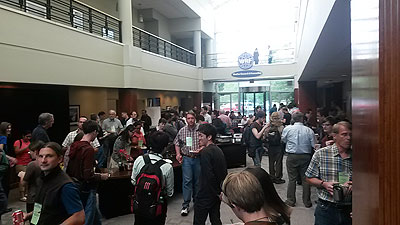|
|
|
| Fig. 1: Coffee break discussions, NCAR Green Center Copyright: Sebastian Knist |
The 16th Annual WRF Users' Workshop
15-19 June 2015, Boulder, Colorado, USA
The WRF Users' Workshop annually takes place at the National Center for Atmospheric Research (NCAR) in Boulder, Colorado. It brings together both a broad community of users and developers of the Weather Research and Forecasting (WRF) model. This year there were about 200 participants, from PhD Students to Senior Scientists coming from 30 countries, but mostly the USA. Since I'm using WRF for the regional climate simulations being part of my PhD thesis, this Workshop was a great opportunity to learn about new developments and best practices in the broad range of setups as well as to discuss my own model simulation results and research questions.
The first day started with lectures about the WRF model's dynamics and physics by the main WRF developers Bill Skamarock, Joe Klemp and Jimy Dudhia. Here, also some new features of the latest model version and best practices for the setup depending on the applications were presented.
Each of the following days started with sessions about specific model components and applications. This included presentations about testing individual model physics, data assimilation, WRF-Chem and regional climate which was of specific interest to me. The talk of Cliff Mass with the title “Is WRF getting better?” showing a validation of several old and new WRF versions caused an intentional discussion. It pointed out that a new version with individually improved model components is not necessarily better in overall performance, at least not for all meteorological parameters. Again, also many other presentations concluded that a best model setup is hard to find, but verification shows which particular combinations parametrizations are more useful for specific applications and regions.
In the afternoon several group discussions were organized. Here, the experiences with individual model components were exchanged, new strategy for accommodating physics packages was discussed and suggestions for an improved user support were made.
Surely, one of the most interesting parts of the week were the discussions during the poster session on Wednesday, where I also presented a poster on “Added value in convection-permitting WRF climate simulations for central Europe”. Since here everybody was familiar with the WRF model, less time for explaining the model settings itself was needed and discussions were more focused on the results. The overall positive feedback was encouraging and increased confidence to have chosen a useful experiment design and model setup. Although there were just a few contributions at the workshop, high-resolution, convection-permitting regional climate simulations for at least decadal time slices get more and more in the focus of interest.
On the last day further hands-on sessions continued including tutorials for output diagnostic and visualization software (NCL and VAPOR) and the Model Evaluation Testbed (MMET).
Fortunately, there was also the opportunity for me to have a separate meeting beside the workshop with WRF developers and climate scientists from NCAR. I could present and discuss the effect of a bug in WRF's lateral boundary treatment we investigated and which is relevant for long-term climate simulations.
Last but not least, besides the interesting and successful WRF workshop, Boulder with its beautiful landscape at the foothill of the Rocky Mountains and its interesting people is worth visiting also for other events or working at NCAR.
PhD Student: Sebastian Knist - Meteorological Institute, University of Bonn, Germany
PhD project: "Water cycle processes and land-atmosphere interactions in multi-scale regional climate change simulations with the WRF atmospheric model over Europe in the context of the WCRP Euro-CORDEX initiative"
Presentation title: “Added value in convection-permitting WRF climate simulations for central Europe”
Abstract: http://www2.mmm.ucar.edu/wrf/users/workshops/WS2015/short_abstracts/p20.pdf











